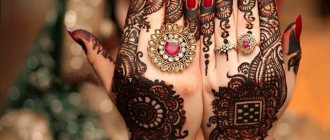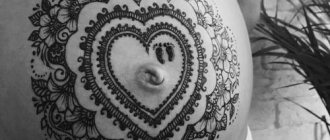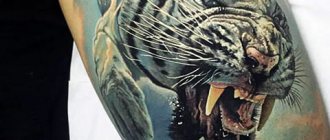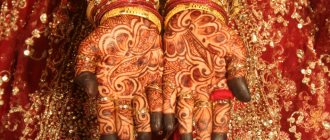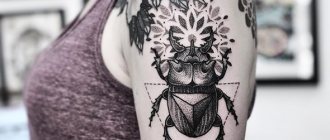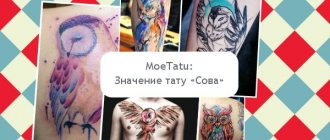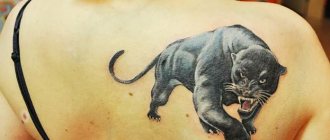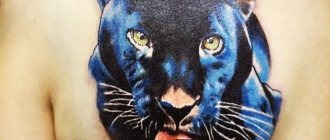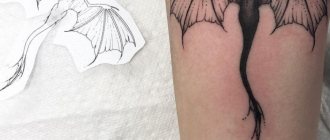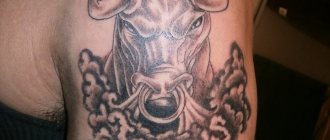Mandala
It is one of the main symbols of Buddhism. Mandala is a peculiar, schematic model of the world. It is also called a map of the cosmos. Mandala is used in henna drawings or tattoos as a conductor of the secret sides of man, his inner qualities to the outside world. Mandala means harmony and wholeness of personality.
Who to choose. Mandala should be drawn by those who want to solve the inner conflict, sort out their feelings or order their thoughts.
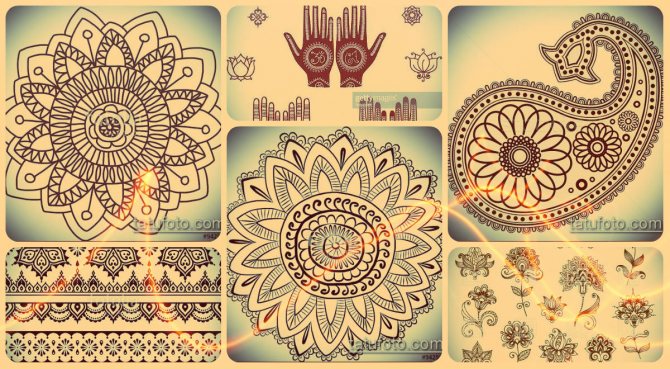
The meaning of mehendi elements - examples of drawings
The symbolism of mehendi
Nowadays mehendi is mainly for beauty, but in Eastern countries this tradition is closely intertwined with religious ceremonies and carries a sacred meaning. If you look at any single drawing, you can usually identify an element that carries the main meaning: the sign "Om", peacock, lotus, flowers and others. Any drawing does not carry a destructive destructive meaning, but aims at: -protection from the evil eye and spoilage -success and good luck -wealth and prosperity -health and vitality. FLOWERS AND THEIR WEAVING:
- A symbol of spring and beauty, life and the universe. They encourage a person to realize their inner world in a more gentle, feminine way. CUCUMBER:
(aka Indian cucumber, Turkish bean, Oriental cucumber, Allah's teardrop, buta, paisley - a drop-shaped decorative ornament). - In India, it is believed that this shape is one of the symbols of movement, development, and energy. It is no coincidence that the "cucumber" ornament often adorns the wedding attire of Indian brides and it is one of the most popular elements of wedding mehendi.
LOTOS:
- A symbol of fertility, health and spirituality, purity and eternal life. Since ancient times it has been associated with the symbol of the female womb where life is born. The motif of the lotus-sitting deity or the lotus-bearing deity is common to many religions.
THE SUN
- door of the universe, the entrance to the world of knowledge and immortality. The sun means the all-seeing deity and power, and its rays bring life into our world. SWASTIC: - one of the oldest and most complex symbols. The word itself means "all is well". In India, the swastika symbolizes movement, happiness and good fortune, it is often used as a seal on jars of holy water. SMALL DOTS (AND LINES OF THEM)
- The symbol of the love that a woman feels for her husband Grain: - abundance in the home, wealth. LINE:
- THE VINE - symbol of devotion, because it reaches for the light and needs to be propped up. - A LINE OF CROWN - good luck, overcoming difficulties, success in career. - LIANA - perseverance, success in ventures. - LINE WITH GRAINS AT THE END: Abundance in the home. A circle: is a universal symbol of wholeness, but in India it also has a special meaning of a turn of life. The circle signifies integrity and security, balance and order SPIRAL:
- indicates the development and dynamics of the inner process, it is a symbol of knowing oneself, an inner journey and immersion, for if we do not know ourselves, we cannot hope to know the world around us. Similarly to the circle, the spiral is associated with the image of infinity and embodies the ideas of development and continuity of cosmic rhythms. Heart: - symbolizes love, happiness, will, courage, appreciation, enlightenment.
THE "OM" SIGN
- is the symbol of divine love, which guides everything, pervades everything, organizes and perfects everything in this world.
The syllable Om is the original sound that creates the universe. Symbol of the infinity of spirit, the Sacred in the world and man. Signifies victory over Chaos. Helps to establish a connection with one's deepest self. According to Indian spiritual sciences, God first created sound, and out of these sound vibrations came all the phenomenal world. Our existence consists of these primal sounds that trigger mantras. Matter itself is said to have emanated from the sound OM, which is therefore considered the most sacred of all sounds. The three curved lines with which the "om" is drawn symbolize the primal energy of Adi Shakti, which divided into three forms (creation-continuation-destruction) to create all being. These three lines also symbolize the three states of consciousness - dream, sleep and reality; the three times of day and the three abilities of man: desire, knowledge and action. It is the ancient sign-base of all mantras, the beginning of all sounds, and the sound of true love. The visual form purifies the mind and attunes to the comprehension of truth. OM was transformed into "AUM" for Hinduism practitioners, "OMIN" for Muslims, and "AMIN" for Christians. and Christians into "Amen", thus uniting and reconciling different views.
MANDALA
In translation from Sanskrit the word "mandala" means a circle and is a drawing within a circle. In its deeper meaning, mandala is the extraction of essence. It is a deep work with our unconscious, which helps us to find wholeness, restores the harmony of our soul. Mandalas are best known in Buddhism, Hinduism, where meditation with them has a ritual meaning and at the same time there is a process of self-integration.
Ornament surrounding an arm or leg: An ornament framing an arm or leg causes energy to be concentrated in the area in question. It is also necessary to say that such an ornament will encourage the person to do what he or she has taken on, with the utmost effort. And to the end.
Elephant
Also a popular element of mendi. This sacred animal traditionally symbolizes power, honor, intelligence, nobility and power. In addition, the elephant signifies longevity and overpowering goodness.
Who to choose. Elephants should draw men to show courage and bravery. On a woman's body, the image of an elephant will mean wisdom and tranquility. As a wish for longevity, the elephant can be drawn by people of advanced age.
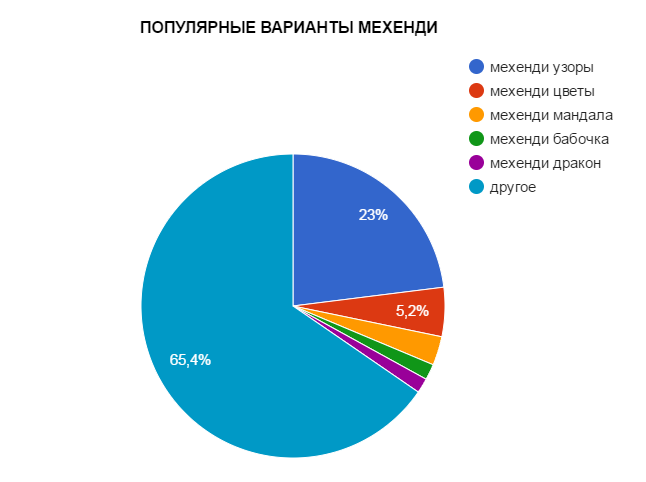

Popular options:
- patterns
- flowers
- mandala
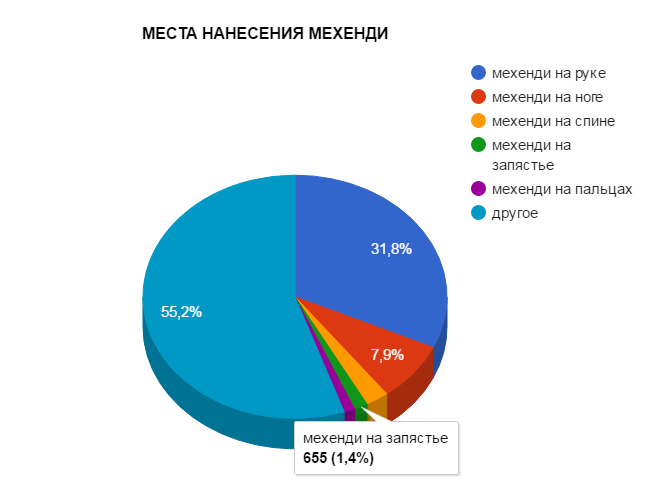

Places of application:
- on the arm
- on a leg
- on the back
- on the wrist
How to make a mehendi with a lotus?
Mehendi is a temporary henna drawing on the body, which will disappear completely after a month. You can make your own mehendi paint and try this art at home. Another option is to go to a beauty salon, where mehendi painting services are already actively offered.
Henna is quite safe, so there are no contraindications for mehendi. But if the coloring technique uses dyes, it is necessary to test the composition on a small area of the skin and make sure that it is safe.
on the back and neck medium lotus on the back large lotus on the back
When you decide to make mehendi, the lotus is the perfect introduction to this oriental art. The lotus symbols represent only the best and the painting technique is painless and harmless so don't be afraid of making mehendi. Feel the touch of the East.
Peacock
This bright bird took on a special meaning in Hinduism. It symbolizes the beauty and fullness of life. It is also a symbol of the personal qualities of the person who drew it.
In addition, this drawing will also indicate the special personal qualities of the person who made it: nobility, striving for perfection, sensuality. The image of this bird is recommended to those who seek prosperity and well-being, recognition and fame, respect.
The image is suitable for people with talents, striving to discover them. In Islam, the peacock means imperishability of the human soul, duality of human nature.
Modern rare and beautiful female names
What is the mystery of the beautiful plant
This miracle of nature grows in water and is valued in many Eastern cultures. For them, it is a shrine. The history of this symbol dates back to the ancient East. Buddhists pay special attention to it and elevate it to a special rank. If you visit India, you will see that the image of the lotus is found at every step and photo.
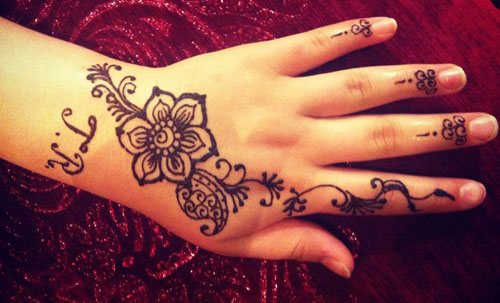

In the good old days, people believed that this flower is gifted with tremendous power: it grows in the swamp and seeks upwards from the mud, mud and darkness to the pure light, the sun. Mention of it can often be heard in the legends of Brahma and Buddha. In every sacred painting there is an image of this amazing plant.
Interestingly, in spite of all the greatness, this gift of nature is often used in cooking, added to cosmetics and spa treatments with it.
What does the symbol of the lotus flower mean in mehendi:
| Interpretation | Source |
| Universe | This meaning was invented by the people of the Mayan tribe |
| Beauty | In many cultures it is a symbol of human striving to know beauty in all its forms and manifestations |
| Purity, purity. | Japanese concept of innocence. |
| Rebirth, divine birth | From a legend in which it is said that the Buddha was born from a blooming water lily |
| serenity, peace | A common explanation that came from the fact that the plant's stem is sturdy and it grows slowly |
| Immortality | The sun gods and the lotus are two inseparable symbols in Egypt, hence the belief that it is a sign of eternal life |
| Fertility | In hard times, the Orientalists used the lotus to flee disease and starvation. |
| Development and spiritual growth | The lily constantly reaches for the sun, despite the dirt that surrounds it |
| Sun and Light | Interpreted from Iran |
| Intellect | In Egypt, the blue flower is the embodiment of wisdom and knowledge |
| Fortune, creation, perfection, success, happiness | Modern explanation |
| Feminine | The most common meaning in India |
| Revealing abilities | Tales of Buddhist monks say that the lotus helps unlock secret desires that lurk deep within the soul |
| Goddess Aphrodite, love | This is how the flower is commonly spoken of in Roman and Greek cultures. |
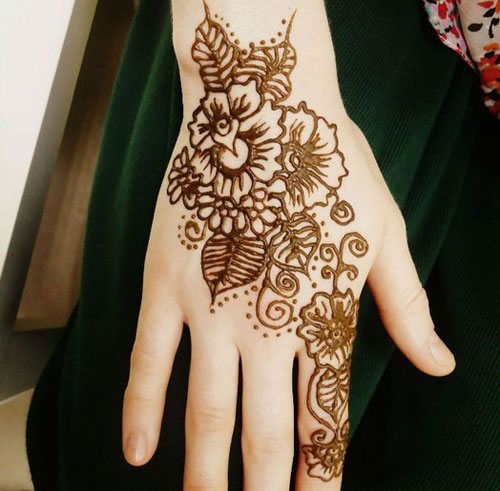

There are many stories about what sacred meaning the water lily has for different peoples, but all the narratives contain one meaning - it is a good symbol that helps, protects and gives strength to develop.
What is mehendi and what is its history
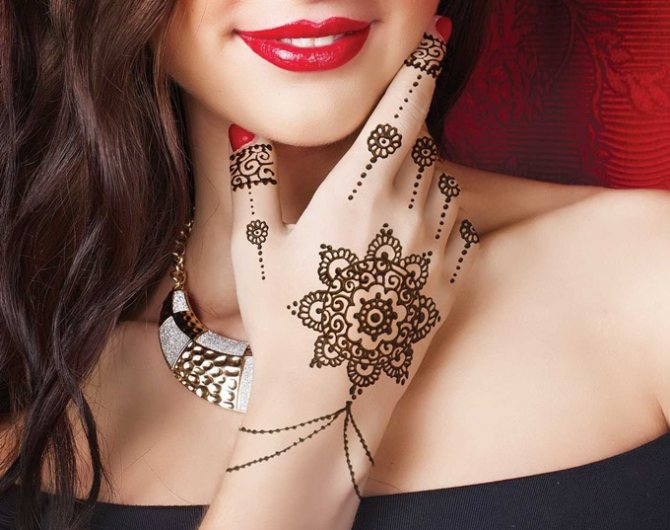

What is mehendi or mendi is known to many. It is the art of decorating your body with drawings made with natural henna, which came to us from the East. The word "mendi" translates from Hindi to "henna". Researchers have not yet been able to determine exactly in what country this trend was born. According to historians, it could have been India or ancient Egypt. Centuries have passed since then, but the technique of applying mehendi (otherwise known as camphire or kofer) has remained unchanged. If compared to the classic tattoos, which are common in European countries, this painting does not damage the skin and can not cause any disease.
Recommended reading:
There are several reasons why this cultural tradition is widespread around the world. Some girls see it as a way of self-expression, a chance to stand out from the crowd, a fashion trend. Others, who have studied the issue more deeply, know that with the help of fantastically expressive drawings you can protect yourself from negative influences.
Today you can find four styles of mehendi - Arabic, Asian, Indian and North African (Moroccan):
Mendi or mehendi: catching grooms and good luck (plus photos from a real Indian wedding!)
These drawings are called mendi or mehendi. I'm more comfortable saying mehendi, because it's fuller-sounding. And there is something mysterious, alluring, elusive about the word. And it's true, unlike a tattoo, mehendi gradually washes out of your skin. A couple of weeks go by and it's as if it never existed.
Mehendi is about 5,000 years old: at first it was used to decorate the bodies of the noble ladies of Ancient Egypt. In the 12th century the fashion for henna drawings appeared in India, in Arab countries and in Africa. Women of several continents to this day believe that mehendi brings happiness and protects against bad luck, so before the wedding brides (and sometimes grooms) are literally painted. By the way, the remaining henna after the cosmetic procedure is buried in the ground to protect the marriage and avoid infidelity of the husband.
The patterns and motifs of mehendi are different everywhere, depending on the region. Here, for example, is the African mehendi.
It is a drawing from Yemen.
The Middle Easterners prefer plant patterns, the Bedouins who live in the desert sometimes just dip their feet and palms in henna, without delving into the subtleties of decoration, in Indonesia you can often find fully painted pads of fingers, sides of the palms and feet. But the most skillful creators of mehendi are probably Pakistanis and Indians.
Firstly, they don't stop at the feet and palms, painting all hands and feet, and secondly, mehendi - is an obligatory component of a bright and opulent Indian wedding. My friend Anya (with whom, by the way, I introduced you: ".A friend, a dove, the rain, the city (pretending to be Italy)".) recently went to a wedding in India - here are her pictures and impressions from Indian mehendi.
"In the spring I was lucky enough to attend the Indian wedding of my friend from Jayantika University. The wedding festivities and numerous ceremonies lasted four days. I arrived just in time for the mandi party on the second wedding day. There was a lot of fun that evening: meeting friends from the bride and groom's side, dancing to music from Indian movies and Punjabi drums.
The main entertainment for the guests was the opportunity to make themselves henna drawings - mendi. Of course, I was happy to take part.
They drew in two hands, so that it would be quicker.
And that's what happened!
They didn't spare any henna for the only European guest at the wedding!
And all the girls, even the littlest ones, were lining up for the guest painters.
Actually the mendi ceremony is an obligatory ritual for the bride, but this evening the bride, my friend Jayantika broke the rules - she just had fun talking to her friends and relatives.
Girlfriends and a friend of the bride (the bride in the center demonstrating the mendi)
She decided to postpone her mendi ceremony to the next day for convenience. After all, the wedding ceremony itself would not take place until 2 days later, and the ornaments might get damaged during the pre-wedding party. The girls did it in half an hour (and I had to dry it for an hour or so, trying not to touch anything), but Jayantika spent at least 4 hours: they decorated her hands from both sides up to her elbows, and her feet from the feet to the knees! It is believed that the richer and more intricate the pattern, the happier will be the life of the newlyweds. By the way, according to tradition, the bride has the right not to do her homework until the pattern is washed off. (Take note!)
The guests of the feast and the bride who gets her hands painted
Very beautiful and even kind of scary, it seemed to me from the lack of experience. However, when I saw my friend in traditional wedding attire and jewelry, the dried drawings looked very elegant and complemented the luxurious wedding image.
A bride in a traditional "lenga choli" wedding outfit
This is all, of course, only a tenth of my impressions of the Indian wedding - it's very bright. So are the mendi patterns. Even though they faded over time, they reminded me of how great it was for a long time!"
Thank you, Anya! Back to the European world.
In Europe, the history of mehendi is very short - few people understand the symbolism, so for white girls it is exclusively a summer decoration. With mendi patterns have been seen Madonna…
…Beyonce
…Jessica Simpson
…Rihanna I even got a mehendi tattoo two years ago.
I also decided to create a summer-romantic mood for myself, went to the salon for mehendi and the accompanying drawing good luck. The henna comes in brown, black, and even color. As master Roxana explained to me, black henna is brighter but lasts less than brown henna. In addition to that, the black and colored henna can have allergic reactions to delicate skin, so we settled on the traditional brown henna. Roksana treated my hands with a special oil before she drew.
Then she began to apply the pattern directly from a pile, as if baking (materials from India).
Painstaking work, of course. You have to be a very patient person!
After the top layer of the pattern dried, the master went over it with a cotton pad soaked in tea and lemon, to make the drawing stick.
Such beauty has turned out!
I also tried to draw on paper. I thought it wouldn't be hard. But no, my hand shakes, henna comes out of the pile and does not lay down as it should. So it's better to go to a master. By the way, there is no need to rush to remove the dried henna - it is better to soak it again with a absorbent cotton in tea - so more pigment is absorbed. For 6-8 hours, try not to wet the painted areas, and then, if you want the pattern to hold for a long time, before the shower, anoint the drawing with any oil of vegetable origin. The skin will be covered by a thin film that will protect the henna from being washed away. And in general, the less soap, the longer the henna will last. This, of course, is not a call to antihygiene! Moreover, you can repeat the henna pattern and even apply one more layer on top according to the old sketch.
Peculiarities of a henna tattoo at home
Beginners should stop at a simple and small drawing or use a special stencil.
- First, degrease the skin - wipe it with alcohol.
- Apply the stencil and carefully apply the paste. Or just paint according to the sketch.
- Wait until the paste is completely dry. This will take 20 to 30 minutes.
- Remove the dried paste. Red and brown henna crumbles with sand and crumbs, and black henna peels off with a film of powders.
- After an hour, gently brush the pattern with lemon oil.
When using brown henna, you may notice a peculiarity: after a day, the pattern becomes much brighter than it was immediately after application - the color is gaining strength in your skin.
After applying the pattern within 24 hours it is undesirable to wash this area of the skin, rub it with a towel. In addition, for the first few days you should sleep carefully, trying not to touch the freshly drawn picture on your face and body - otherwise the ornament may be imprinted on your cheek, forehead or stomach.
Only until May 13.
After a while, the lower classes of Egyptian society began to paint their bodies in mehendi designs because it was easy to buy henna. Later on, this technique was applied in the Middle East, North Africa and Asian countries.
In Central Asia and India, the usual natural henna is used more often, so the drawings turn out brown or reddish shades. In Morocco and other North African countries, henna with the addition of charcoal or ash is used - the patterns on the skin turn out darker and even black. In many countries where mehendi is popular, during pregnancy, women get patterns on their ankles and abdomen to protect the fetus from evil eyes.
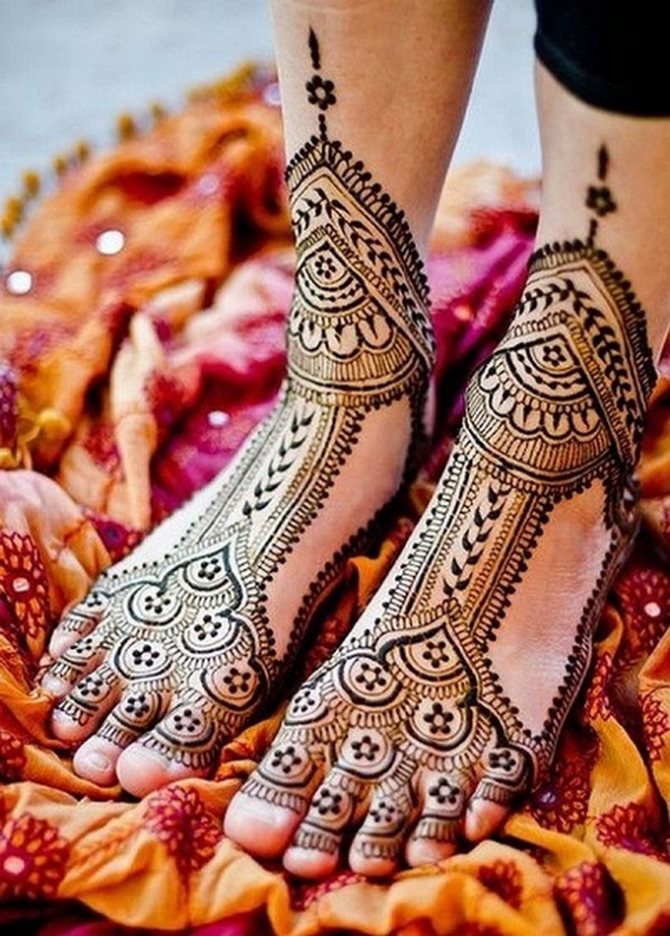

According to the traditions of Islam, only brides and married women could decorate themselves with such paintings. Muslims were forbidden to put tattoos on their bodies because after the procedure, the body was no longer as Allah had intended it to be. Women in particular were concerned. They could only display the exquisite beauty of mehendi to their husbands. Gloves and socks hid the patterns on the hands and feet, which were considered too intimate adornments and were only meant to heighten the passion in the marital bedroom.
Indian women love mehendi. In this country, three-year-old girls already decorate their hands and feet with bright patterns. More often girls walk around with drawings made with henna, but you can also meet men with paintings on the body.
For girls who were about to become brides, applying mehendi to the skin took on a special meaning. Symbolic images on the arms, shoulders, legs and feet, performed by experienced older female relatives, were supposed to initiate the future wife into the intimate knowledge necessary in the matrimonial relationship. This ritual could last five hours or longer, sometimes even taking two nights, as they tried to make as dense, exquisite and vivid a painting as possible. If henna remained, it was to be buried in the ground so that the husband would never cheat on his wife.
How to make mehendi paste at home
You can buy body henna at any store of Indian goods and spices. There are colorful tubes of paste-like henna on sale. It can be brown, red, red and black. The finished version in a tube is very easy to use, and you do not have to spend a lot of time to make it - you can immediately start painting. But if you like to learn the process from beginning to end, you can prepare paste for mehendi at home. To do this, it is better to use a special pigment for dyeing the body rather than hair. In total, the preparation of the composition takes about a day. The recipe below involves making 100 grams of dye.
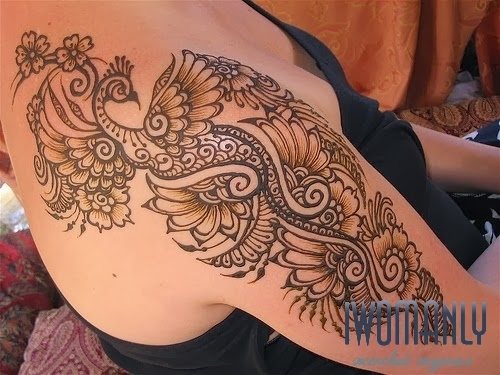

Ingredients:
- - henna in powder - 20 grams;
- - two lemons;
- - granulated sugar - 1 teaspoon;
- - any aromatic oil (sandalwood, eucalyptus, tea tree, orange and so on) - 1 teaspoon.
Tools:
- glass or plastic bowl,
- measuring spoon
- plastic bags or cling film.
- Squeeze the juice from two lemons and strain it. Sift the henna.
- In a glass bowl, combine the henna and 50 ml of lemon juice, mix well. Cover the bowl with plastic wrap and leave for 12 hours in warmth.
- Add sugar and aromatic oil to the paste, mix it. It is necessary for the drawing on the skin to be clearer and more persistent.
- Gradually add lemon juice and adjust the mixture to the consistency of toothpaste. If the paint is too liquid, you can add a little more henna.
- Cover the bowl with clingfilm and leave it in a room for 12 hours again. The coloring mixture is ready. You can store it up to 3 weeks in the fridge or 4 months in the freezer in an airtight container. Before using it, it is worth warming in a water bath.
Rules for applying henna feather patterns on the body
Patterns on the body look beautiful and stylish almost anywhere, but this picture is a real decoration for the back, foot, spine, shoulder, hand and neck. Men prefer massive, intricate ornaments executed in a single color. For guys, it is a symbol of determination, courage, boldness, which characterized the warriors of Indian tribes. Tattoo protects against disease, trouble, helps to achieve victory and cope with the bitterness of defeat.
Girls like modest and concise henna drawings with feathers, in which there is no unnecessary piling up. For the most part, these are neat and stylish pictures. They serve as a talisman against spoilage, evil eye and execution of evil spirits.
In order to become a witch, you must wear a scarf and a necklace of hijacked wool ornament. For them, it is a symbol that helps them find inspiration.
Depending on the color scheme, the tattoo may carry a different semantic load:
- black and gray - strong spirit;
- Red - victory over life's obstacles and circumstances, over enemies;
- blue and green - the desire for calm, stability;
- purple and violet - identify the principality of the bearer of mehendi, his strong temperament and hard character;
- orange and yellow - mental harmony, coziness, tenderness, lack of ambition and serious life principles.
Often men like to draw a feather with a skull. This pattern looks frightening and its meaning is unusual - these two objects link the world of the living and the dead. Who can dare to do such a henna sketch? Most likely it is fans of esotericism, mysticism.
There are special elements that give the drawing a special meaning:
- A feather in flight means sadness, sadness, longing;
- A feather in flight - means sadness, melancholy, sadness, separation from a loved one, the other half;
- a cut object - the loss of something valuable, severe emotional pain, suffering, acknowledgement of one's defeat.
It is important that the attribute belongs to a certain type of bird:
- Eagle - wisdom and honor, courage and fearlessness, agility and strength, the ability to survive in any situation. The Indians believed in the power of this symbol and believed that a tattoo with it would help a person acquire the qualities and character of this majestic king of birds;
- From the phoenix - immortality, the beginning of a new life, renewal;
- owl - a sign of intelligence, protects from evil spirits, helps to survive. This mehendi is often applied by lovers of magic;
- Ostrich - henna tattoo with a feather indicates that a person loves truth and justice. Many thousands of years ago, the inhabitants of Egypt worshipped the great goddess of order and justice named Maat, who was always drawn and sculpted with this bird attribute on her head. No trial was ever held without this deity's image. Legends say that she was the one who decided where a person would go when they died.
- The Firebird - elegance, mysterious personality, physical and mental beauty;
- crane - a sign of eternal life;
- without the sign of belonging to any species - talent, courage, inner strength, faith, spirituality, freedom.
If the body image of a large massive feather in combination with birds pointing upwards, then you have an elevated, freedom-loving person, who goes forward to the goals set, despite all the obstacles and difficulties.
The henna painting of peacock feathers has a special meaning. This mehendi is associated with the shining sun and stars. Different ethnic groups denote openness and spiritual purity with this sign. It protects from evil spirits, trouble, and life's problems. In the modeling business it is believed that this picture brings good luck.
Girls like to decorate their ribs, ears, abdomen, feet, neck with the peacock attribute. Most often, ladies hide their tattoos and do on closed areas. The owners of such patterns are honest, positive, patient and conscientious.
But sometimes the tattoo can indicate arrogance and vanity of its owner, so it is made small and hidden on a closed area of the body.
Sexy and expressive looks mehendi henna in the decollete area. For this, it is better to choose a bright and rich plumage. On the scapula, collarbone, outer part of the thigh, ankle, arm ornaments in a realistic embodiment look beautiful. A small image on the finger or wrist looks stylish. The back, decorated with an image of a feather, emphasizes the grace and elegance of the owner. The ornament, supplemented with flowers, birds and precious stones looks original.
Choose mehendi at your discretion and always listen to your feelings and intuition, but do not forget about the meaning and sacred meaning of the symbols.
Modern life is already difficult to imagine without mendi, this cultural entertainment is very tightly integrated into our lives. Patterns are applied not only by young people, but also by children during holidays and interesting events. Who at least once did a temporary tattoo, remains under a pleasant impression for a long time. And what pattern is especially popular with girls?
The spiral .
A variety of spirals - easy drawings in mehendi. More often they form the basis of the composition. On this sign are strung other, so creates a more complex and meaningful drawing.
In itself, the spiral is a prototype of infinity. The symbol of the spiral is the thirst for self-discovery, which is experienced by man. He wants to know his inner world, and for this he makes a difficult journey inside himself along the spiral.
Cream color: combination, application
The spiral signifies the infinity of the world and its knowledge. It also signifies the "kundalini," the energy sleeping in each person, which, when awakened, connects with the universe.
Such a drawing will suit those who are at a crossroads in life, who have important choices to make, who are looking for themselves.
